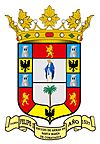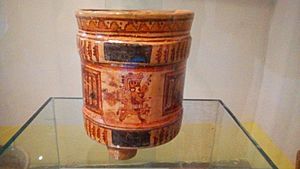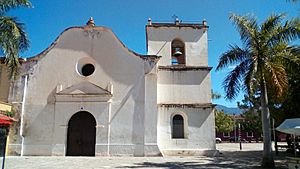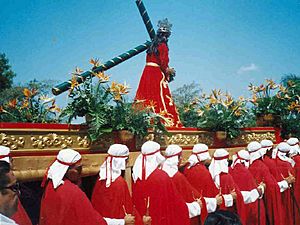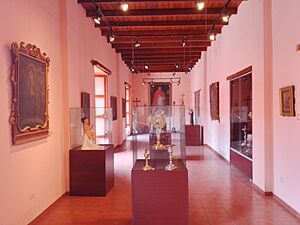Comayagua facts for kids
Quick facts for kids
Comayagua
Santa Maria de la Nueva Valladolid de Comayagua
|
|||
|---|---|---|---|
|
Municipality
|
|||
 |
|||
|
|||
| Country | |||
| Department | Comayagua Department | ||
| Foundation | 8 December 1537 | ||
| Nearby Large Cities |
List
|
||
| Area | |||
| • Municipality | 834 km2 (322 sq mi) | ||
| Elevation | 594 m (1,949 ft) | ||
| Population
(2023 projection)
|
|||
| • Municipality | 184,694 | ||
| • Density | 221.46/km2 (573.6/sq mi) | ||
| • Urban | 127,018 | ||
| Time zone | UTC-6 (CST) | ||
| Website | comayagua.hn | ||
Comayagua is an important city and municipality in Honduras. It used to be the capital of the country. It is located about 80 kilometers (50 miles) northwest of Tegucigalpa, the current capital. The city sits about 594 meters (1,949 feet) above sea level.
Comayagua has grown a lot over the years. Between 1945 and 1975, its population grew very quickly. In 2023, the city's population was estimated to be around 120,500 people. Comayagua is the capital of the Comayagua Department and is famous for its beautiful Spanish Colonial architecture. Its main cathedral has the oldest clock in the Americas.
Contents
What Does the Name Comayagua Mean?
Comayagua is often called "La Antañona" by people in Honduras. This means 'the old one'. It got this nickname because it's one of the oldest cities in Honduras. It also still has many old buildings from the time when Spain ruled the area. Its historic center is the most restored and well-kept in the whole country.
The Spaniards first called the place "Valladolid" or "País de las Higueras", which means 'country of the fig trees'. But the city kept its original local name, Comayagua. Most people agree that the name comes from two words: koma, meaning 'huge amount of land' in the Lenca language, and jawa, meaning 'water'. So, Comayagua likely means 'abundant land of water'.
Comayagua's History
Early Times: Before the Spanish Arrived
Long before the Spanish arrived, the valley where Comayagua is located was home to the Lenca people. They were a native culture from Mesoamerica, and their descendants still live in Honduras today. Old archaeological sites, like Yarumela, show that these people lived in the valley as far back as 1,000 B.C.
The flat land and warm climate helped the Lenca people thrive. They built their own societies and towns. They were important in controlling trade routes that connected the Caribbean Sea to the Pacific Ocean. When Spanish explorers came to the Americas, they found a rich valley with many well-organized Lenca towns. These native groups bravely resisted the Spanish during the conquest of Honduras.
How Comayagua Was Founded
Comayagua was founded in 1537 by a Spanish captain named Alonso de Cáceres. He was told to find a good spot to build a city between the two oceans. This order came from Francisco de Montejo, who was the first governor of what was then called Hibueras (now Honduras). The city was first named "Santa María de la Concepción de Comayagua."
In 1542, the King of Spain ordered that an important court, the Real Audiencia, be located in Guatemala. However, a year later, it was decided that this court should be in Comayagua. The city was then renamed "Villa de la Nueva Valladolid de Comayagua" to honor Valladolid in Spain. But in the end, the court was moved to Gracias Lempira in 1544.
In 1557, King Philip II of Spain officially gave Comayagua the title of "city." By this time, Comayagua already had a convent and a stone church. In 1561, the main church leadership (episcopal chair) was moved to Comayagua from Trujillo. This was because Comayagua was in the center of the country and close to gold and silver mines. The first cathedral was built in 1585, and the current one, called the Immaculate Conception Cathedral, was started in 1634 and finished in 1715.
Comayagua During Spanish Rule
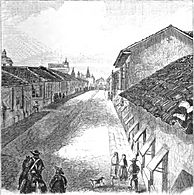
Comayagua remained the capital of Honduras throughout the entire time Spain ruled the area. The Spanish built many important buildings in the city, such as churches, colleges, convents, houses, and fountains. Comayagua was the first city in Honduras to have a system of aqueducts to bring water.
However, another city, Tegucigalpa, started to become more important in the mid-17th century because it was a mining center. Tegucigalpa even received the title of "town" in 1768.
Despite Tegucigalpa's growth, Comayagua became an "Intendancy" in 1788, which meant it had more political power over Tegucigalpa. This caused rivalry between the two cities. People in Tegucigalpa complained that these changes hurt their economy. They said that new leaders in Comayagua were not interested in mining and added taxes on farm products that only helped Comayagua.
Because of these complaints, the Mayor's Office in Tegucigalpa was brought back in 1812. Even so, Comayagua continued to decline. By the early 1800s, it was described as a quiet town with few Spanish families, many of whom relied on charity. The city also gained a reputation for being unhealthy due to its economic problems. In 1802, Comayagua had a population of 5,369. Some people suggested moving the capital to Tegucigalpa, but Comayagua remained the capital until the end of Spanish rule.
Independence from Spain
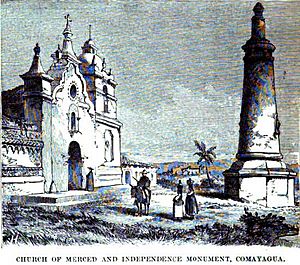
Around the time of independence, many groups in Central America wanted to be free from Spain. In Honduras, these movements started in Tegucigalpa. Many important people, like Dionisio de Herrera and Francisco Morazán, were part of these groups. The leaders in Comayagua saw these people as troublemakers.
However, the Spanish rule was coming to an end. On September 21, 1821, Central America declared its independence from Spain. Comayagua received the news on September 28 and accepted the decision.
Later, in November 1821, General Agustín de Iturbide of Mexico suggested that Central America join Mexico to form a large empire. This idea caused disagreements in Central America. In Honduras, Comayagua supported joining Mexico, but Tegucigalpa was against it. In the end, Central America joined the Mexican Empire on August 22, 1822. However, this empire did not last long. Iturbide gave up his power in March 1823, and on July 1 of that year, Central America declared its final independence. Comayagua and Honduras became part of the United Provinces of Central America.
The Burning of Comayagua
After Honduras became part of the United Provinces of Central America, Comayagua remained its capital. In 1824, Dionisio de Herrera was elected as the first Head of State of Honduras. But soon, there was opposition against him. The President of the Republic, General Manuel José Arce, saw Herrera as a problem.
A leader named Irías caused trouble and led to an invasion of Honduras. President Arce sent his forces, led by Colonel Justo Milla, to overthrow Dionisio de Herrera. On April 4, 1827, Milla's troops surrounded Comayagua.
Comayagua was largely burned and looted during this attack. Even though the city's defenders were outnumbered, they might have won if their commander, Colonel Antonio Fernández, had not betrayed Mr. Herrera. Fernández put Herrera in prison and made a deal with Colonel Milla on May 9. Herrera was then taken to Guatemala.
Justo Milla temporarily took control of Honduras. But on November 11, 1827, he was defeated by General Francisco Morazán in the battle of La Trinidad. Morazán then went to Comayagua and took control of the state of Honduras.
Moving the Capital City
The rivalry between Comayagua and Tegucigalpa grew stronger over time. In June 1849, a decree was issued to move the capital to Tegucigalpa, but it was not fully carried out. Comayagua continued to be the seat of government.
Throughout the 18th century, Tegucigalpa gained more importance. Important institutions, like the Literary Academy (which later became the National Autonomous University of Honduras), were built there. Finally, on October 30, 1880, President Marco Aurelio Soto made the decision to move the capital of Honduras from Comayagua to Tegucigalpa. This ended the long-standing rivalry between the two cities.
After the capital moved, Comayagua's population, businesses, and overall importance decreased significantly. By the early 19th century, its streets were not well-maintained, and public buildings were in poor condition. However, Comayagua still remained the center of the diocese (church district) of Honduras.
Comayagua's Geography and Climate
Comayagua is located in a valley surrounded by mountains. To the west are the Montecillos Mountains. To the east are the Comayagua mountains, which connect to the Esquías mountains. To the south are smaller mountain ranges like Lepaterique.
Weather in Comayagua
Comayagua has a tropical monsoon climate, which means it has a wet season and a dry season.
| Climate data for Comayagua (Comayagua International Airport) 2016–present | |||||||||||||
|---|---|---|---|---|---|---|---|---|---|---|---|---|---|
| Month | Jan | Feb | Mar | Apr | May | Jun | Jul | Aug | Sep | Oct | Nov | Dec | Year |
| Record high °C (°F) | 36.0 (96.8) |
36.1 (97.0) |
37.2 (99.0) |
38.4 (101.1) |
36.7 (98.1) |
34.6 (94.3) |
34.5 (94.1) |
35.1 (95.2) |
33.3 (91.9) |
35.6 (96.1) |
35.3 (95.5) |
35.0 (95.0) |
38.8 (101.8) |
| Mean daily maximum °C (°F) | 30.8 (87.4) |
32.9 (91.2) |
34.9 (94.8) |
34.9 (94.8) |
34.7 (94.5) |
32.1 (89.8) |
30.0 (86.0) |
30.0 (86.0) |
29.0 (84.2) |
29.5 (85.1) |
29.9 (85.8) |
30.2 (86.4) |
30.8 (87.4) |
| Daily mean °C (°F) | 22.8 (73.0) |
23.6 (74.5) |
24.2 (75.6) |
25.0 (77.0) |
24.6 (76.3) |
23.9 (75.0) |
23.5 (74.3) |
23.5 (74.3) |
23.3 (73.9) |
22.3 (72.1) |
22.0 (71.6) |
22.8 (73.0) |
22.1 (71.8) |
| Mean daily minimum °C (°F) | 15.9 (60.6) |
14.6 (58.3) |
18.4 (65.1) |
19.8 (67.6) |
20.4 (68.7) |
19.0 (66.2) |
19.5 (67.1) |
19.7 (67.5) |
19.6 (67.3) |
19.3 (66.7) |
14.4 (57.9) |
14.2 (57.6) |
17.1 (62.8) |
| Record low °C (°F) | 8.9 (48.0) |
11.0 (51.8) |
13.0 (55.4) |
12.0 (53.6) |
12.0 (53.6) |
15.5 (59.9) |
13.5 (56.3) |
12.2 (54.0) |
15.0 (59.0) |
12.5 (54.5) |
10.1 (50.2) |
12.0 (53.6) |
8.9 (48.0) |
| Average rainfall mm (inches) | 29 (1.1) |
33 (1.3) |
50 (2.0) |
56 (2.2) |
176 (6.9) |
279 (11.0) |
355 (14.0) |
319 (12.6) |
338 (13.3) |
208 (8.2) |
53 (2.1) |
29 (1.1) |
1,925 (75.8) |
| Average rainy days (≥ 0.1 mm) | 1 | 1 | 1 | 5 | 13 | 20 | 20 | 20 | 20 | 16 | 4 | 2 | 123 |
| Average relative humidity (%) | 55 | 56 | 56 | 60 | 67 | 68 | 82 | 83 | 86 | 83 | 76 | 72 | 70 |
| Source: Climatedata.org | |||||||||||||
Interesting Places to Visit
Right in front of the main plaza is the City Hall. This building has been rebuilt a few times and has a classic style from the 19th century. The Cathedral of the Immaculate Conception was built during the time of Spanish rule in Honduras. It opened on December 8, 1711. Inside the cathedral, you can find the oldest clock in America. It was made by Arabs in Spain around the year 1100 and was later given to Comayagua as a gift from King Carlos III.
Another interesting spot is the Plaza de San Francisco. It has a park and a colonial church nearby. This church holds the Antonina Bell, which is the oldest bell in America, cast in Spain in 1460.
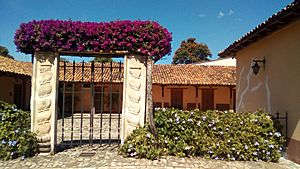
Many houses in the city still have their original Spanish Colonial architecture from the 18th century. Some of these houses have been turned into museums. Important ones include the Museum of Colonial Religious Art, the Archaeological Museum (which has items from the Lenca people from before the Spanish arrived), and the Republican Museum.
The Plaza de la Merced is another square in the old town. It's known for a monument called the obelisk. In front of it is the Iglesia de la Merced, which was the city's first cathedral before the current one was finished in 1711.
The Caxa Real is another attraction. This colonial house was built between 1739 and 1741. It was designed as a place to store tributes (taxes) for the Spanish crown. Gold, silver, and other metals from Honduran mines were processed here before being sent to Europe. The building was damaged by earthquakes in 1774 and 1809.
The Caxa Real was rebuilt in 2013 and is now an events center. It has hosted important international figures, like Queen Letizia of Spain and former Mexican President Enrique Peña Nieto. The Plaza de San Francisco is also notable for having one of the oldest churches in Honduras, built in the mid-16th century. It was the second church built in Comayagua.
Comayagua's Heritage
Comayagua has a rich architectural, cultural, and artistic heritage. Some of its buildings date back to the mid-16th century, making them among the oldest in Central America. In terms of culture, Comayagua is one of the few cities in Honduras that still practices Spanish traditions in the same way they were introduced centuries ago.
Famous Buildings
- La Merced Church (1550)
- San Francisco Church (1560)
- San Sebastián Church (1580)
- La Caridad Church (16th century)
- Comayagua Archaeological Museum (House built in the late 16th century)
- Immaculate Conception Cathedral (1634)
- Religious Art Museum/San Agustín College (1678)
- Paseo la Alameda (Old colonial houses turned into restaurants)
- Cabañas House Museum (18th century house)
- Santos Guardiola House Museum (18th century House)
- Caxa Real (1739)
- Cádiz Constitution Monument (1812)
- Government Palace (1880)
Cultural Traditions
Semana Santa (Holy Week) is a very famous Roman Catholic holiday celebrated in Comayagua. It is still practiced in the same Spanish way that was introduced in the 16th century. Every Holy Week, people create beautiful "alfombras de aserrín" or colored carpets made from wood dust. These carpets show scenes from the life of Jesus of Nazareth and other biblical figures like the Virgin Mary. These traditions came from southern Spain and were practiced in Guatemala and Honduras during the colonial period. The Holy Week celebrations in Honduras are often compared to those in Andalusia, Spain, because they are so similar to the old Spanish Catholic traditions taught to the native people.
Other famous traditions in Comayagua mix native and Spanish elements. One example is el baile de los diablitos (little devils dance). Dancers wear colorful clothes and masks that look like animals, people, or mythical creatures. This tradition started in the 17th century when native people combined their religious rituals with Catholic ones.
Art in Comayagua
Comayagua has many pieces of art from different time periods. You can see pre-Columbian Lencan art in the pottery at the archaeological museum. There are also art pieces from the time of Spanish rule, some dating back to the late 16th century. The main altar of the Immaculate Conception Cathedral was made in Jaén, Spain, in the 17th century.
This altar is considered one of the most beautiful baroque art pieces in Honduras. The city's many other churches also have beautiful altarpieces and paintings. Most of these art pieces are now kept in the city's museums, like the Museum of Religious Art. The archaeological museum also displays artworks by different Honduran painters from across the country.
Comayagua International Airport
The new Comayagua International Airport is becoming one of the most important airports in Honduras. It is much larger than the Toncontín International Airport in Tegucigalpa. This new airport is expected to serve not only Comayagua but also people living in Tegucigalpa, because Toncontín has limited space for growth. The new airport could become the main airport for the capital.
The new airport can hold 20 aircraft, and its terminal building is over 39,000 square meters (420,000 sq ft), which is about four times the size of Toncontín. It also has the third longest runway in Honduras, after the airports in San Pedro Sula and La Ceiba.
Soto Cano Air Base
Soto Cano Air Base (formerly Palmerola Air Base) is a military base located less than 10 kilometers (6 miles) from Comayagua. This large airbase, which is 3 kilometers (2 miles) wide and 10 kilometers (6 miles) long, is home to the Honduran Air Force Academy. The United States also has a military presence there, called Joint Task Force Bravo, with about 550 US military personnel and over 650 US and Honduran civilians. Part of the airport is also used for civilian flights as the Comayagua International Airport.
Sports in Comayagua
Comayagua is home to Club Hispano, a soccer team in the Honduran National Soccer League. The team first joined the National League in 2004–05. However, after their first season, they were moved back to the second division. So, the club's leaders bought a first-division team from another club to stay in the top league. Club Hispano plays its home games at the municipal stadium 'Carlos Miranda', which can hold about 10,000 fans.
Comayagua also hosted the first International Fellowship of Christian Athletes Motocross camp in September 2012. Sixty men and women took part in the camp, learning from professional riders from the United States. The camp was followed by a race in memory of Dylan First, a US rider who passed away on the track the year before. This motocross event is now held every year in Comayagua.
See also
 In Spanish: Comayagua para niños
In Spanish: Comayagua para niños



